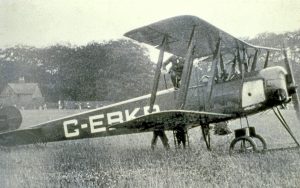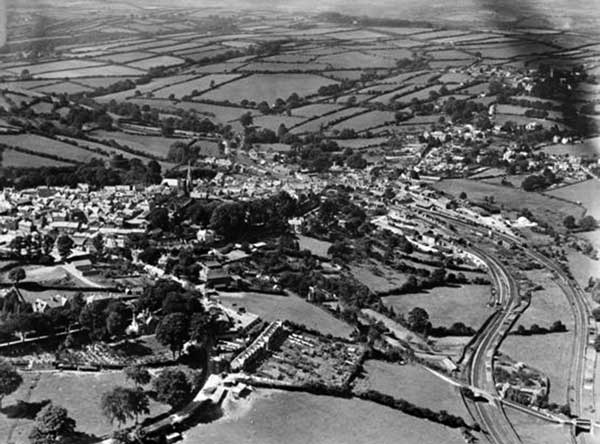.
In January 1924, Cornish and Devon editor, Maurice Prout, took a plane ride above the town and here is his reporting on occasion.
To have carried over 75,000 passengers without mishap is a record of which any motor company might be proud, but this can also be said of the concern which is responsible for brining the bi-plane to Launceston and giving passenger flights. This was the first opportunity given to residents of the town to experience the delightful sensation of flying, in addition to which there was the advantage of being enabled to take a bird’s eye view of their town. Few can appreciate the beauty of the landscape as seen from above, and very few would object to a second trip providing funds were available.
Anxious to see what his native town looked like from this point of view, and with the hope of being able to provide readers with a photographic view, a member of the literary staff of ‘The Cornish and Devon Post,’ armed wit a camera kindly loaned by Messrs Hayman and Son, made a flight on Saturday, and again on Monday, about 2.30 p.m.. On each occasion the second passenger seat was vacant. A ladder is placed against the side of the machine, and after the pilot, Captain F. G. M. Sparks (a former Lieutenant in the R.A.F. during WW1 below) of Berkshire Aviation Tours, had taken his seat, our representative climbed in.

The seats are situated one behind the other, the pilot’s in front. They are of the bucket-seat pattern, and it is possible to get one’s legs underneath and thereby gain, a sense of security if at all nervous, for, contrary to the popular plea, passengers are not strapped in. With a tremendous roar and a rush of air we are off. The ground sinks gently away and soon we have mounted sufficiently high to get a view of the surrounding country. Having anticipated something of the feeling experienced on a tossing and pitching ship, there was an agreeable surprise. Gently banking the machine to turn, we head for the town, of which we get a magnificent view. The pilot kindly manoeuvred into what he considered the best position and slowed down to 20 miles an hour. Standing and reaching over, the camera was pointed backwards and downwards between the wing and tail and the shutter released. The sun rather unkindly almost hid itself behind a cloud at the critical moment, but the result gives some idea of the ancient borough as seen at height. Banking at a steep angle in the wind, the pilot again circled the town and another plate was fired off. The business part over, there was then an opportunity of enjoying the ride. The toy houses far below stood out clearly and the streets could easily be seen. The glistening streams in the valley could be traced for a long distance, and the reservoir on Windmill resembled nothing more than an ink-pot of blue0black ink. It is a strange fact that persons who are naturally nervous on the edge of a precipice, do not experience dizziness when looking out over the side of aeroplanes, with nothing but space between them and terra firma. The whole trip was a very smooth one, the return to the filed being in the teeth of a stiff wind. The pilot effects remarkably gentle landings, planning down without using the engine. The plane down is so gradual that ‘that sinking feeling’ in one’s anatomy is entirely absent.

The pilot inspires confidence, without which no ride could be enjoyable. The exhibition he gave on Sunday (with Mr. W. Jasper, of Davidstow, and Mr. Scantlebury, of Lifton Down), as passengers, was conclusive evidence that he is able to get out of any situation he is likely to find himself in. Next week he will give another exhibition of a spinning nosedive, looping the loop, rolls, stalls, half rolls and Immelman turns, etc. Captain Sparks always lands without the aid of the engine, so that, should the engine fail when aloft, it would make not the least difference, as he would merely plane down as he always does.

This is the first visit to the West of the Berkshire Aviation Tours bi-planes and it is noteworthy that they are the only people who make flights for 5s. The engine of the bi-plane is a 110 horse-power Le Rhone of nine cylinders (above). Control of the machine is with the usual ‘joy-stick,’ which moves six parts together – one piece on each wing, and a piece each side of the tail, the rudder being controlled by a foot lever. The petrol is pressure fed, but in case this fails, there is a small tank on the top of the plane, by which the engine could be gravity fed. It is of interest to note that the machine flies exclusively on ‘B.P.’ 1 motor spirit, well-known for its super power and reliability.
Berkshire Aviation Tours were part of Northern Air Line based in East Hanney, nr Wantage; Ford; Witney; Hanworth, who operated from 1919 until 1929. The plane that they used was probably a Avro 504K G-EBKB which they were flying in 1924.

Visits: 80
